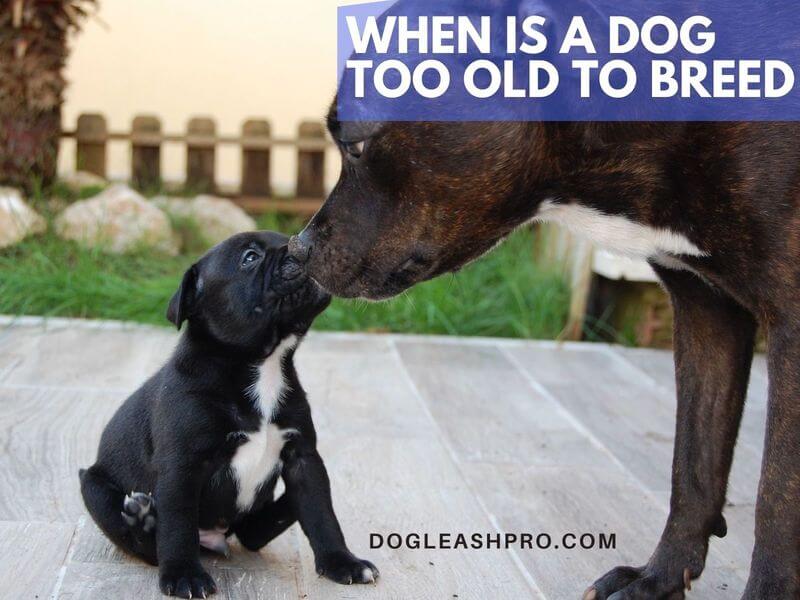

Dogs age faster than humans. They reach puberty early and grow old within a decade. Like humans, their ability to reproduce declines with age. For dog breeders wishing for their dog’s offspring to have all the desirable traits of their parents or pet owners wanting their dogs to bear adorable pups, knowing how old can a dog have puppies is vital.
When is a dog too old to breed? A female dog is too old to breed when she reaches 5 to 6 years of age. A male dog is too old to breed when he reaches 10 to 12 years of age. Keep in mind that this answer also depends on multiple factors including the dog’s age, breed, general health, mental health, and if they had any previous injuries.
Older dogs are also prone to developing a health condition called entropion. Be sure to check out our article, Why Do Dogs Wink? to find out if your senior dogs are winking at you or if they have a serious genetic health condition that needs to be looked at right away.
Table of Contents
What is the oldest age a dog can have puppies?

If you have older dogs, you may think that they are not capable of producing puppies especially when they may not have as much energy as before or no longer want to head out for walks several times a day like they did when they were puppies.
There is no straightforward answer here since it depends on several factors which we will touch on below.
First, let’s discuss when a male dog is too old to have puppies.
When is a male dog too old to breed?
Male dogs can keep on breeding a bit longer than females dogs. A generally agreed upon retirement age for stud male dogs is after 10 to 12 years of age.
The age at which he may be too old to breed also depends on the dog’s breed, health, partnering frequency, and medical history.
3 Signs to find out if your male dog is too old for breeding
- The conception rate is low. If under the best possible condition, a male dog repeatedly fails to get the female dog pregnant, it could be a sign to retire the male dog.
- Smaller litter size. The litter size may be smaller than before. For instance, he was producing 6 in a litter and now he is consistently only producing 3 in a litter.
- Signs of declining health. A male dog with health issues such as hormonal changes, unable to move properly, or is starting to have health problems related to breeding, it’s a sign to retire him.
When is a female dog too old to breed?
While female dogs do not have menopause and can stay fertile late into their lives, it is still best to retire them at around 5 to 6 years of age.
Some breeding groups do set the age limit a bit higher than 6 years of age, but keep in mind that female dogs may experience complications during birth or have labor troubles. Thus, it’s crucial for owners and breeders to monitor their health very closely even though they are still capable of breeding and having puppies at as old as 10 years of age.
In addition to health, factors like the female dog’s breed, size, medical history, and how many litters she has birthed so far also affects whether or not to continue breeding and having puppies.
As the female dog ages, she will begin to lose her fertility and her heat cycle will slowly get further apart. Because of this, it can be difficult for older female dogs to have puppies. They may also produce less milk than before and this will affect their litter of puppies.
9 Tips to Know When to Stop Breeding Your Female Dog

1. Consider the dog’s breed
The dog’s breed plays a significant role in determining its maximum breeding age. Smaller dog breeds mature early and can keep on reproducing until their age hits double figures. On the other hand, large dog breeds take a while to hit puberty and may need to retire from breeding after growing 5 to 6 years of age.
Here’s the general rule to follow depending on your dog’s breed and size:
- Small dogs or toy dogs should retire from breeding at 5 years of age.
- Large dog breeds like Labrador Retrievers should retire from breeding at around 5 to 6 years of age.
- Medium-sized dogs can breed longer than both small and large dog breeds. It depends whether they have any medical conditions so speak with your vet if you’re unsure.
2. Breed to improve
For a genetically and physically healthy litter, both male and female dogs have to be compatible. Compatibility does not mean they have to be from the same breed, but they should complement each other at a genetic and behavioral level.
Breeding dogs that are worlds apart in terms of size can make pregnancies complicated. A small female dog would not have enough room in her womb to accommodate a large male’s offspring. Even if the size difference is not too pronounced, smaller females who have bred with larger males may require a C-section during birth.
When breeding dogs with a size difference, the rule of thumb is to have the male belong to the smaller breed and the female to the larger breed.
Inbreeding is another issue that plagues the world of pedigree dogs. Dogs that are supposed to be purebred are sired from closely-related parents and may have little genetic diversity. This puts them at risk of various congenital disorders.
It is also essential to consider partnering dogs’ behaviors and nature. The offspring should be non-aggressive and comfortable around people. Partnering your dog with a naturally aggressive breed would produce offspring that may be dangerous to humans and other animals.
3. Examine the number of litters the dog has produced
Breeding takes a considerable toll on the female dog’s body. With each litter, the female reproductive system gets deteriorated. For the best health of the mother and puppies, female dogs should retire after a certain number of pregnancies.
Most vets and breeding clubs agree that even a healthy female dog should no longer breed and rear puppies after producing 4 to 6 litters.
A dog is not a puppy-production plant. While they can stay fertile for a significant part of their lives, it doesn’t mean you can use them for breeding the whole time.
4. Timing of previous litters
In female dogs, the timing of previous litters matters as much as the number. While a healthy dam can rear up to 5 litters without problems, it is best to space them out so she gets plenty of time to recover.
The breeder’s goal should be the longevity of their dams. Malpractices like breeding the dog too young, too old, too often, or too excessively put the mother and the litter’s lives at risk.
5. Is the dog healthy enough to continue breeding?
Once a female dog is over the age of 5 years, her health needs to be monitored every time before breeding. If there are signs of any health issues that may get aggravated by pregnancy, having her breed may not be a good idea.
The hips of older female dogs may lack the flexibility to expand during whelping or giving birth to puppies. Natural birth, in this case, may be difficult or impossible, and the dog may require a C-section.
Cardiac, renal, or liver diseases may cause fetal development problems and increase the chances of miscarriage.
6. Does the dog have any inheritable health conditions?
Inheritable health conditions, if present in a parent, can spread and multiply in the offspring quickly. Even if the dog appears to be in good health, it may still be a carrier. The more offspring a dog produces, the more the chances of his health issues showing up.
Inheritable diseases are more common in purebred dogs, mainly because they lack the genetic variation to counter these diseases. Some species are also more prone to certain diseases, and having them breed with the same breed can multiply the chances of these health conditions appearing in the subsequent generation.
Always have a detailed health screening of both the male and the female before having them breed. Watch for any abnormalities or disorders that can pass on to their successors. Diseases such as degenerative myelopathy, thyroid disorders, deafness, blindness, hip dysplasia, and heart and kidney problems are common inheritable health conditions in dogs.
7. Any previous complicated pregnancies?
If the dog had previous complicated pregnancies, it’s safe to assume that it’ll happen again. It’s best not to put the dog through that ordeal again if she had trouble with it previously.
Complications like stillbirth, miscarriage, excessive blood loss, or an unexpected C-section should be clear indicators to retire the dog from breeding. To make things safer, have her spayed to prevent unwanted pregnancies.
8. What are some health complications to look out for?
Age is important in female dogs. While the male’s part in breeding ends after partnering, the female’s job continues through the gestation period, birth, and childcare. For females to be in top shape for the whole process, age matters a lot.
Owners should get well versed with all possible complications that a dog may experience during pregnancy. Watch out for the following signs of abnormalities, and call a vet if things don’t seem right.
- Distended uterus.
- Uterine infection.
- Inflamed mammary glands.
- Low blood calcium in nursing dogs.
9. Understand The Heat Cycle
The heat cycle, also called the estrous cycle, has four phases:
- Proestrus: 9 to 10 days.
- Estrus: 5 to 9 days.
- Diestrus: 2 months.
- Anestrus: 7 to 9 months.
During the “Estrus” phase, the dog is receptive to males; this is where partnering takes place.
The length and frequency of the heat cycle depend on the age and breed of the dog. Small breeds and young dogs go into heat more frequently; larger breeds and old dogs, less so.
For the best health of your female dog, do not have her breed through consecutive heat cycles. Skip at least one cycle before letting her get pregnant again.
If you’d like an in-depth explanation of what goes on during a canine pregnancy, the Journal of reproduction and fertility explains it here.
Speak with experienced breeders
If you’re breeding your dog for the first time, there is nothing wrong with asking for help from an expert. Experienced breeders can provide valuable information that can help you through the whole process.
Seasoned breeders can also help you out if your female dog runs into any health complications during or after pregnancy. You can also register with a local kennel club to help breed your dog responsibly.
What should you do if a senior dog gets pregnant

If you didn’t get your senior dog spayed, chances of an unexpected pregnancy are always there. If that happens, the dog needs extra care to stay healthy and deliver babies without complications.
Keep monitoring the dog’s health yourself, and visit the vet frequently. The vet will also guide you on how to best care for your aged, pregnant dog.
Have a whelping box or nesting box ready and get your dog used to it. A whelping box allows the owner to quickly and easily gather the dog and all her puppies and take them to the vet.
All dogs need a rich, healthy, and well-balanced diet to bear with the struggles of pregnancy and labor. This is especially true for senior dogs. However, it’s best to ease your dog into the high-calorie diet so as not to upset her stomach. Let’s discuss it next in more detail.
Provide proper nutrition for your pregnant dog
Your pregnant dog needs to be in top physical shape for the best health of her pups. She also needs to be strong enough to survive whelping or giving birth to puppies without getting too exhausted. For that, she needs a balanced, nutritional meal plan.
Pregnant dogs are fed a diet high in calories. However, it is important to keep it balanced, so the dog doesn’t gain too much weight. The food needs to be high in proteins and fats to help the dog nurture healthy babies.
Make sure not to switch to a high-calorie diet abruptly, as that may cause old dogs to develop digestion issues. Ease the dog into their new diet by gradually increasing the protein and fat contents in their food. Have the food readily available throughout the day, so the dog can eat whenever she wants.
Get your dog accustomed to the whelping box
When it’s time to give birth, dogs look for a safe, warm, dry, and isolated place for the process. This is where a whelping box or a nesting box can be really helpful. If there is no suitable whelping box for your dog to use as a delivery room, she may pick some inconvenient place to give birth.
Senior dogs face considerable risks during labor. In case the dog experiences whelping complications, having her in a box allows you to quickly and conveniently pick her and her puppies up and carry them to the vet.
It is also important to have the whelping box ready well before the due date. This way, the dog can take her time getting accustomed to it. The box should be dry and warm and give her the privacy she needs as well as accommodate her frame comfortably.
Caring for your dog after whelping
After whelping, senior dogs are susceptible to health issues such as uterine infection and mastitis. While reddish secretions are normal after whelping, black secretions are signs of uterine infection. You should also inspect her chest for redness or swelling, as this is a sign of mastitis.
Make sure to observe your dog after she gives birth. If she’s ignoring her puppies, having spasms, or refusing to eat, take her to the vet as soon as possible.
Reproductive issues in both male and female dogs

Intact male dogs are at risk of benign prostatic hyperplasia (BPH) and prostatitis, two common prostate diseases. The older they get, the more they run the risk of contracting these diseases. BPH can cause infertility in dogs and can be very painful.
Pyometra or infection in the uterus affects older female dogs who have spent several cycles without getting pregnant. This problem can usually be cured by spaying the dog. Aged females may also have orthopedic issues, which can make whelping or giving birth to puppies difficult. A prolapsed uterus is a rare condition that can cause spontaneous abortion in dogs.
Dogs can wander off and breed with random dogs if left unsupervised. This puts them at a high risk of STDs, which may result in reproductive problems. Brucellosis is an STI that causes infertility in males and females. Once contracted, it can be very expensive to treat. Always have a medical screening of both dogs before having them breed.
What to do if a dog is too old to breed
Dogs too old to breed must be retired. This means that not only should dogs no longer partake in partnering, but they should be spayed or neutered as well.
Neutering or castrating male dogs improves their behavior and health. Habits like aggression, marking territory, and wanderlust disappears.
Spaying female dogs prevent them from any unwanted pregnancies past their prime. Since female dogs can go into heat at any age, chances of them conceiving are there; even if they’re too old to rear pups.
Final words on responsible breeding
Dogs rely on their owners to watch out for their best interests. They are driven by instincts and may keep on breeding even if their bodies don’t allow it. Dogs also know nothing about genetics. Their owners need to find a compatible, healthy breed for them that will sire the next generation of strong pups. A responsible pet owner watches out for their dog’s health and doesn’t exploit them for monetary gain.
Watch out for your dog’s health. Breed them carefully and responsibly.
Related Questions
It depends on whether you’re breeding a female dog or a male dog. If you’re breeding a female dog, then yes, 7 years old is too old for her to have puppies. Keep in mind that a female dog is too old to breed when she reaches 5 to 6 years of age. At around 7 years old, her heat will decrease so she may not be able to get pregnant quite as often as before but she’ll still be able to bear puppies.
On the other hand, a male dog is too old to breed when he reaches 10 to 12 years of age. So for a male dog, 7 years old may not be too old for him.
Keep in mind that this answer also depends on multiple factors including the dog’s age, breed, general health, mental health, and if they had any previous injuries.
DISCLAIMER: THIS WEBSITE DOES NOT PROVIDE MEDICAL ADVICE
The information, including but not limited to, text, graphics, images and other material contained on this website are for informational purposes only. No material on this site is intended to be a substitute for professional veterinary advice, diagnosis, or treatment. Always seek the advice of your veterinarian or other qualified health care provider with any questions you may have regarding a medical condition.

With over five years of specialized experience as an animal writer, my expertise lies in dog nutrition, health, behavior, grooming, and training. I am dedicated to delivering helpful and informative content that caters to the well-being of our furry friends. My primary goal is to empower pet owners with knowledge and ensure our canine companions thrive in health and happiness. In my free time, I love volunteering at local dog rescue centers.






